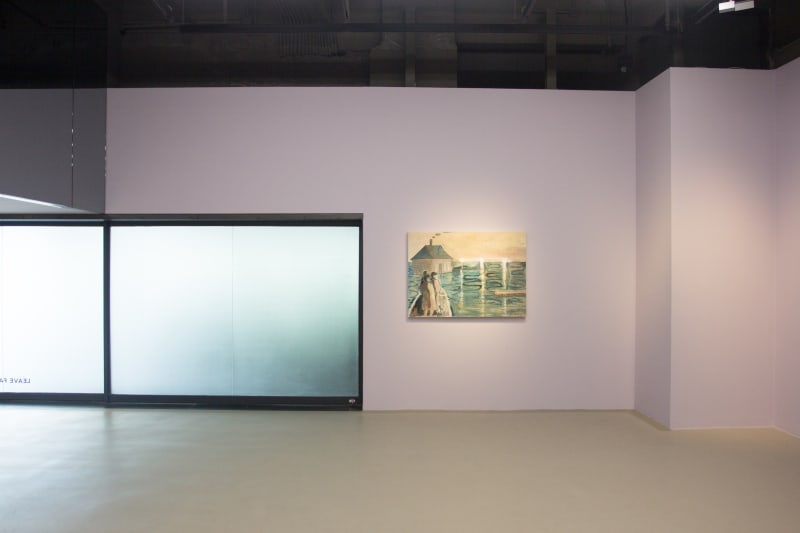The paintings exhibited reveal an unsettling world of Yang’s creation, inhabited by those who live beyond the doctrines of contemporary society. Situated on the very edge of space and time, this is a place where night and day are one, reality and fantasy are synonymous, and our systems of perpetual control are made to disintegrate. A manifestation of the very edge of the human psyche, its sparse landscape becomes a locale for Yang to uncover our collective fears and desires.
Influenced by his prior experience as a book publisher and illustrator, Yang has cultivated a distinctive personal visual language derived from mythologies, fairy tales and painting conventions of both Eastern and Western origins. He revisits early memories of growing up in Jilin and the Chinese ghost stories passed down to him by his grandmother, reconfiguring them in his practice with Western scriptures and painting traditions.
Good Life begins from now on (2017) includes numerous biblical allusions. A house floats perfectly on top a great body of water, as characters, whose faces are detached and slightly obscured, look beyond the horizon embracing three suns. The title, in conjunction with this scene, conveys a sombre sense of renewal after a catastrophic event has come to an end. Leave Far Away (2017) depicts a lone pilgrimage to a realm beyond. A figure travels deeper into a pallid carmine forest, away from other settlers who wander in union elsewhere. Here, Yang reinterprets the rubrics of traditional Chinese landscape paintings, adding a Western brashness that leaves the forest looking harsh and unforgiving.
Scavenger (2017) portrays a hunt undertaken by those who have chosen to endure the expanse of this new land. They don monotonous attires, assuming primitive roles under the pursuit of survival. Untethered to instruments of modern civilisation and aided only by simple tools, their search is embraced by the land’s unusual climate. In Airstrike Manual (2017) two naked women copulate surrounded by creatures with intangible bodies and inhuman faces. These creatures swarm the barren land, their animalistic gaze piercing every corner. The occupants of his work appear homogenous, stripped of present-day vehicles of identification; all bodies are either uncovered or dressed in seemingly utilitarian clothing.
His images are familiar yet uncanny, able to disrupt rationality and incite introspection into our ingrained points of references. Characters and settings appear familiar at first, however, closer inspection reveals perturbing characteristics, with their features having been distorted or reduced to basic curvatures. In Black Swan (2017), the skater’s fingers are fused together and her eyes fade away to reveal a face that is slightly out of human proportion. Similarly, in Action of Wood Frog (2017), two unnerving figures stand dejectedly in front of an otherworldly backdrop. This otherwise mundane site is plagued by black fissures erupting throughout its domain. The inhabitants seem transformed by their surroundings, becoming less recognisable as they venture further into its grasp.
An exemplar of contemporary Chinese art, we hope that this show and the works within it shall stand as a valuable cross-cultural exchange between Thailand and China. Yang’s paintings serve as an allegory for subordinated individuals who dare to resist societal norms, who are displaced and overlooked in both his own country and ours. A symbol of where we have been and could be, his work confronts us with the possibility of humanity's collective return to its primordial state - free from superficial criterions and social constructs.
Zhao Yang, born in Jilin province, 1970 and graduated from the China Academy of Art in 1995. Currently lives and works in Beijing. Recent exhibition include: Zhao Yang: In Between, Kuandu Museum of Fine Arts, TNUA, Taipei (2016); ‘Zao’ by ZHAO Yang, ShanghART, Shanghai (2016); China 8, Contemporary Art from China at the Rhine and Ruhr, Lehmbruck Museum, Duisburg(2015); Une histoire: art, architecture, design des années 1980 à nos jours, Collections contemporaines, Centre Pompidou, Paris, France(2015); Semi-automatic Mode 2, ShanghART Beijing, Beijing (2014); A Mirags Similar Truth Trugbild, ZHAO Yang Solo Exhibition, Galerie Eigenheim, Weimar, German (2013); The Battomless Pit, ZHAO Yang Solo Exhibition, Upto Art Space, Shanghai (2012); Sparkling Signpost, ZHAO Yang's Solo Exhibition, Mouart, Beijing (2012); Jungle: A Close-Up Focus on Chinese Contemporary Art Trends, Platform China, Beijing (2010); BLADE – Reconstruct Leifeng Pagoda, SZ Art Center, Beijing (2009) etc.


